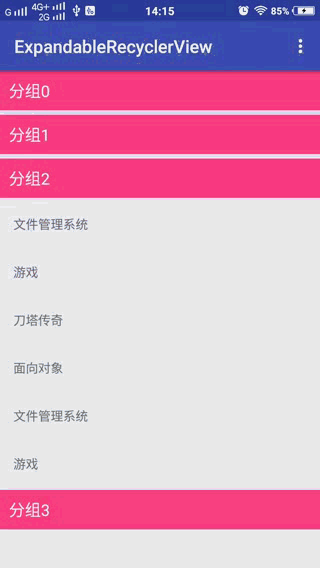Android ExpandableRecyclerView使用方法详解
发布于 2017-09-14 22:27:57 | 194 次阅读 | 评论: 0 | 来源: 网友投递
Android移动端操作系统
Android是一种基于Linux的自由及开放源代码的操作系统,主要使用于移动设备,如智能手机和平板电脑,由Google公司和开放手机联盟领导及开发。尚未有统一中文名称,中国大陆地区较多人使用“安卓”或“安致”。
这篇文章主要为大家详细介绍了Android ExpandableRecyclerView的使用方法,具有一定的参考价值,感兴趣的小伙伴们可以参考一下
本文为大家分享了Android ExpandableRecyclerView的使用,供大家参考,具体内容如下
1.目前只支持两级结构。
2.支持所有组同时全部展开,支持同一时间只能展开一组。
3.GroupView,ChildView高度自定义。
4.支持初始化数据时,指定展开某组数据。
5.支持GroupItem,ChildItem的Onlick,OnLongClick事件。
6.展开收起带动画。
效果图:

使用步骤:加入依赖
compile 'com.drawthink:expandable-recyclerview:0.0.3'
1.继承BaseViewHolder,实现自己的ViewHolder
1.1 在构造函数中初始化你的View(包括GroupView,和childView).
1.2 分别实现以下两个方法,并在对应方法中返回对应Layout布局文件中根节点的ID。
public int getGroupViewResId()
public int getChildViewResId()
示例代码:
public class ImageViewHolder extends BaseViewHolder {
public ImageView image;
public TextView tvTitle;
/**
* 初始化你的View(这里包括GroupView,和childView)
*/
public ImageViewHolder(Context ctx, View itemView, int viewType) {
super(ctx,itemView, viewType);
image = (ImageView) itemView.findViewById(R.id.iv_image);
tvTitle = (TextView)itemView.findViewById(R.id.tv_title);
}
/**
* @return 返回你的GroupView 布局文件中根节点的ID
*/
@Override
public int getGroupViewResId() {
return R.id.group;
}
/**
* @return 返回你的ChildView 布局文件中根节点的ID
*/
@Override
public int getChildViewResId() {
return R.id.child;
}
}
/**
* author:Drawthink
* describe:
* date: 2017/5/22
* T :group data
* S :child data
* VH :ViewHolder
*/
public abstract class BaseRecyclerViewAdapter<T,S,VH extends BaseViewHolder> extends RecyclerView.Adapter<VH>
示例Adapter代码:
public class ImageAdapter extends BaseRecyclerViewAdapter<String,ImageBean,ImageViewHolder> {
private Context ctx;
private List datas;
private LayoutInflater mInflater;
public ImageAdapter(Context ctx, List<RecyclerViewData> datas) {
super(ctx, datas);
mInflater = LayoutInflater.from(ctx);
this.ctx = ctx;
this.datas = datas;
}
@Override
public void onBindGroupHolder(ImageViewHolder holder, int groupPos,int position, String groupData) {
holder.tvTitle.setText(groupData);
}
@Override
public void onBindChildpHolder(ImageViewHolder holder, int groupPos,int childPos,int position, ImageBean childData) {
holder.image.setBackgroundResource(childData.getResId());
}
@Override
public View getGroupView(ViewGroup parent) {
return mInflater.inflate(R.layout.title_item_layout,parent,false);
}
@Override
public View getChildView(ViewGroup parent) {
return mInflater.inflate(R.layout.item_image_layout,parent,false);
}
@Override
public ImageViewHolder createRealViewHolder(Context ctx, View view, int viewType) {
return new ImageViewHolder(ctx,view,viewType);
}
}
完成以上两步之后,基本大工告成,由于ExpandableRecyclerView的数据是要分组的,所以提供了RecyclerViewData来封装
/**
* @param groupData
* @param childDatas
* @param isExpand 初始化展示数据时,该组数据是否展开
*/
public RecyclerViewData(T groupData, List<S> childDatas,boolean isExpand)
那接下来看下数据具体是怎样封装的。
mDatas = new ArrayList<>();
List<ImageBean> bean1 = new ArrayList<>();
List<ImageBean> bean2 = new ArrayList<>();
List<ImageBean> bean3 = new ArrayList<>();
// 每个子列表长度可以不相同
bean1.add(new ImageBean("Dog", R.mipmap.dog));
bean1.add(new ImageBean("Dog", R.mipmap.dog));
bean2.add(new ImageBean("Cat", R.mipmap.cat));
bean3.add(new ImageBean("Bird", R.mipmap.bird));
mDatas.add(new RecyclerViewData("Dog", bean1, true));
mDatas.add(new RecyclerViewData("Cat", bean2, true));
mDatas.add(new RecyclerViewData("Bird", bean3, true));
所有工作以完成,现在你可以象平常使用Adapter,RecyclerView一样,来愉快的写代码了。
注意:在对元数据mDatas进行增删操作时,要调用adapter.notifyRecyclerViewData();否则会造成数据索引错乱的问题。
代码github地址
以上就是本文的全部内容,希望对大家的学习有所帮助,也希望大家多多支持PHPERZ。